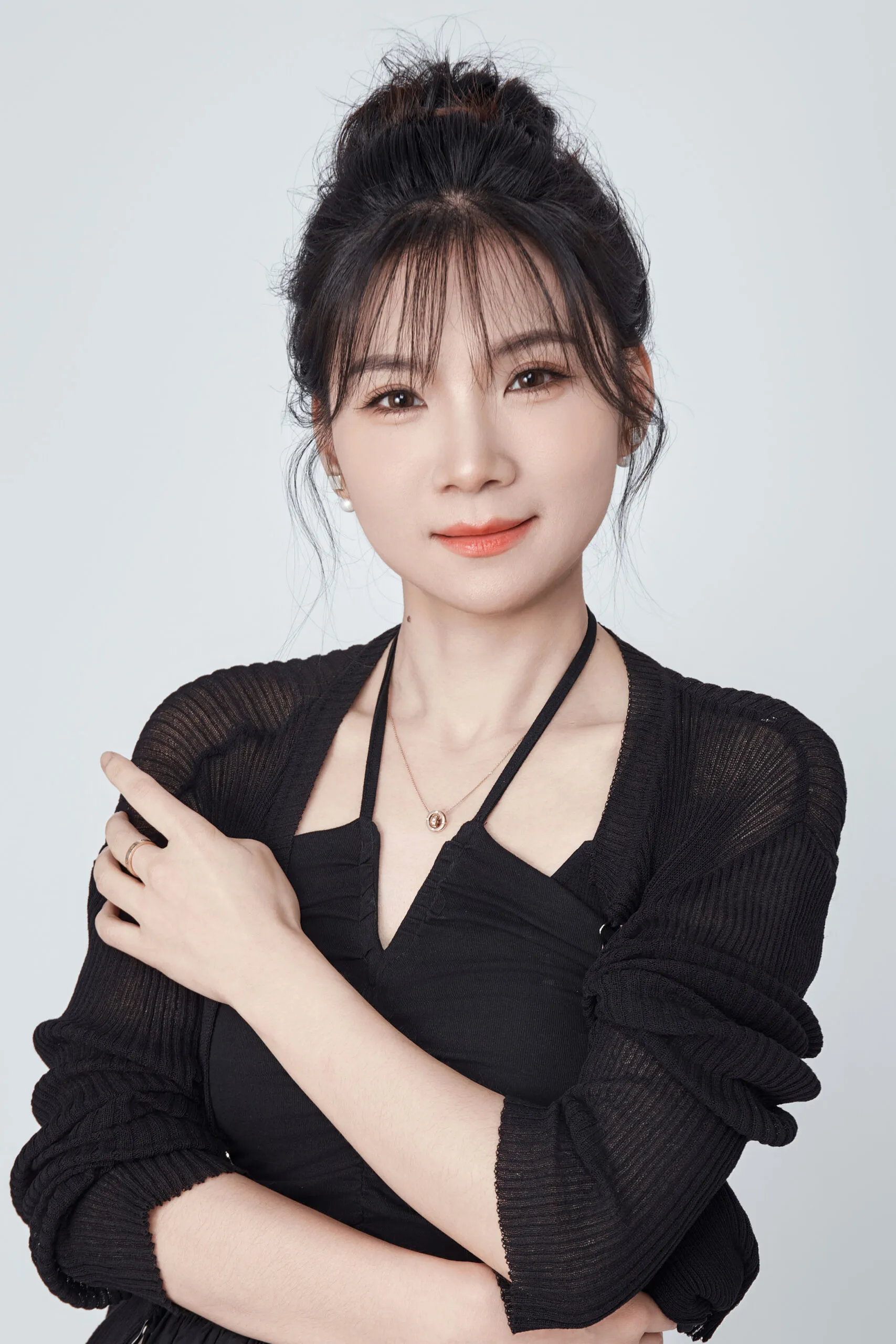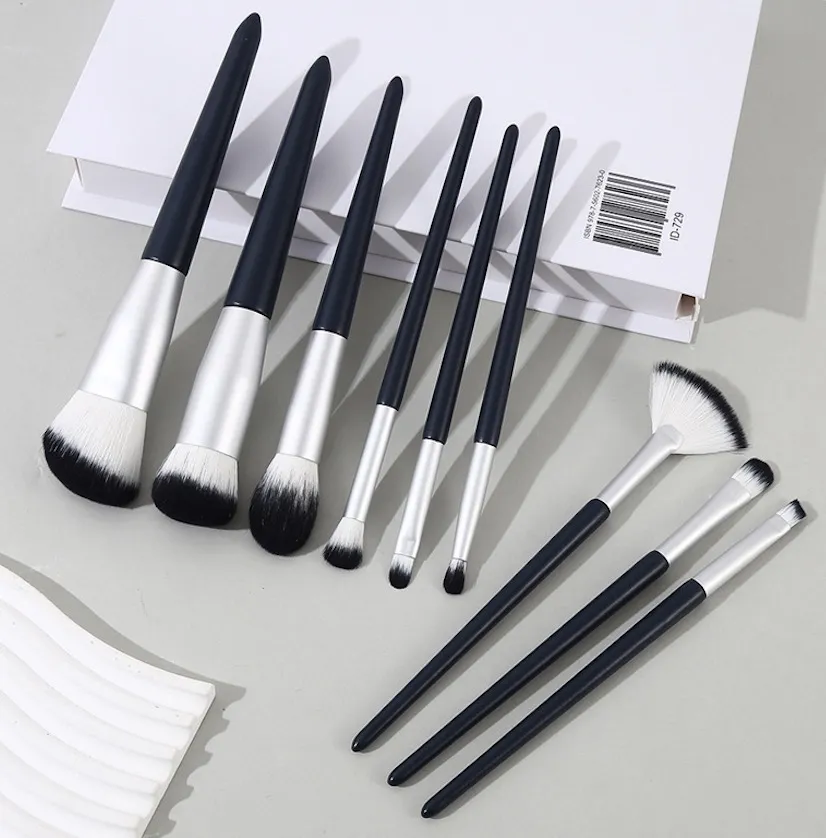Choosing a brush handle feels overwhelming. A wrong choice can hurt your brand’s image, break your budget, and delay your launch. I’ll help you make the right decision.
For B2B buyers, the best way to choose is to match the material to your brand, use case, and finish durability. Anodized aluminum1 is great for a premium feel and sustainability. Bamboo or FSC wood tells a renewable story. Expect MOQs around 5,000 units and 8–10 week lead times.
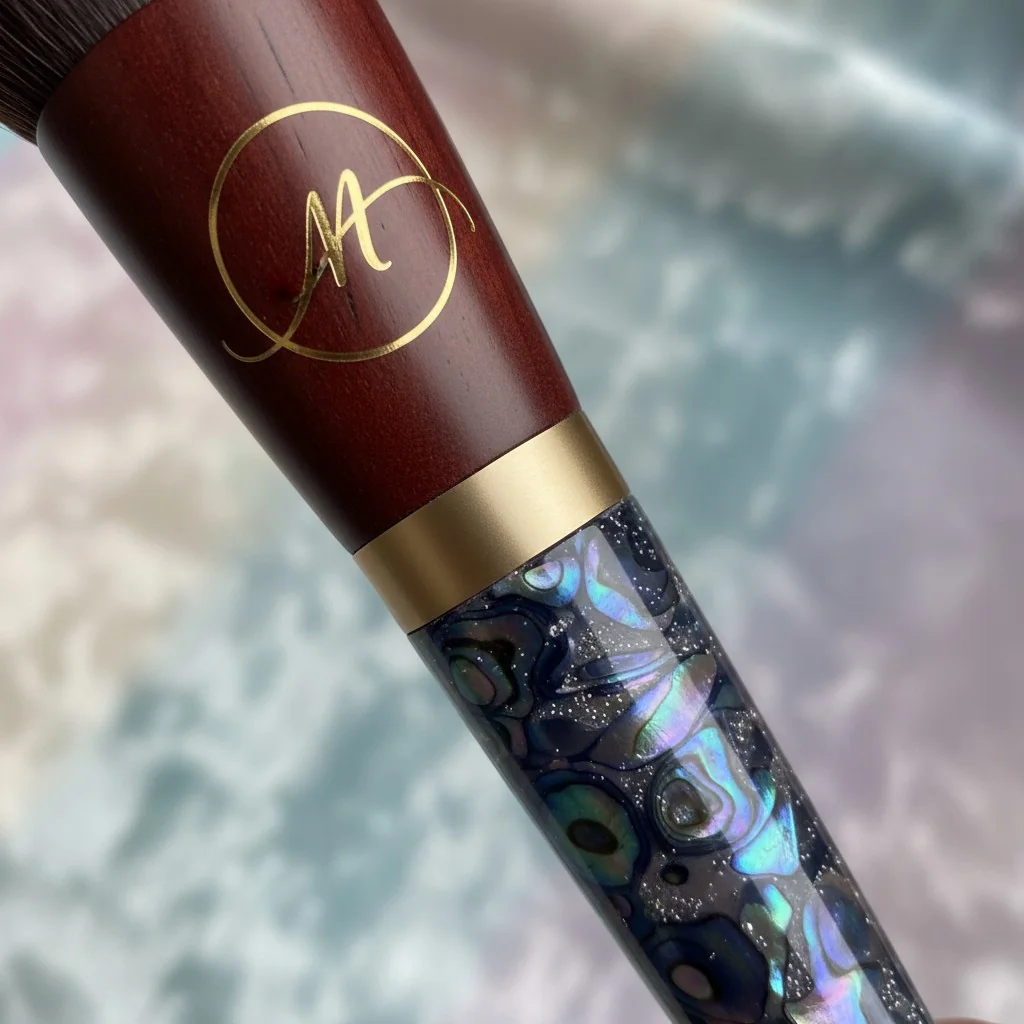
When I first started on the factory floor, I saw so many brands struggle with this. They would pick a handle based only on looks. Then, they would get complaints about chipping paint or handles warping in a humid bathroom. It’s a costly mistake that can damage customer trust. But you can avoid this. The key is to think about the material, the finish, and the end-user all at once. Let’s break down how to choose the perfect handle that looks great, performs well, and tells your brand’s story.
Recycled aluminum uses about 95% less energy to produce than primary aluminum.True
This is a widely cited statistic from sources like The Aluminum Association, making it a powerful and verifiable claim for your brand's sustainability story.
All bamboo handles are 100% waterproof without any treatment.False
Bamboo is a natural material and requires proper sealing with quality lacquer to resist moisture and prevent warping or cracking in humid environments like a bathroom.
Which handle material (wood, bamboo, aluminum, or acrylic) is most durable with the best finishes?
Your beautiful brush handles are chipping, or customers say they feel cheap. This damages your brand’s reputation and leads to returns. You need to understand Material durability2 from the start.
Anodized aluminum is the most durable, resisting scratches and solvents. Well-sealed wood and acrylic are great but need quality checks for moisture and UV exposure. Bamboo offers a strong eco-story but also needs proper sealing.
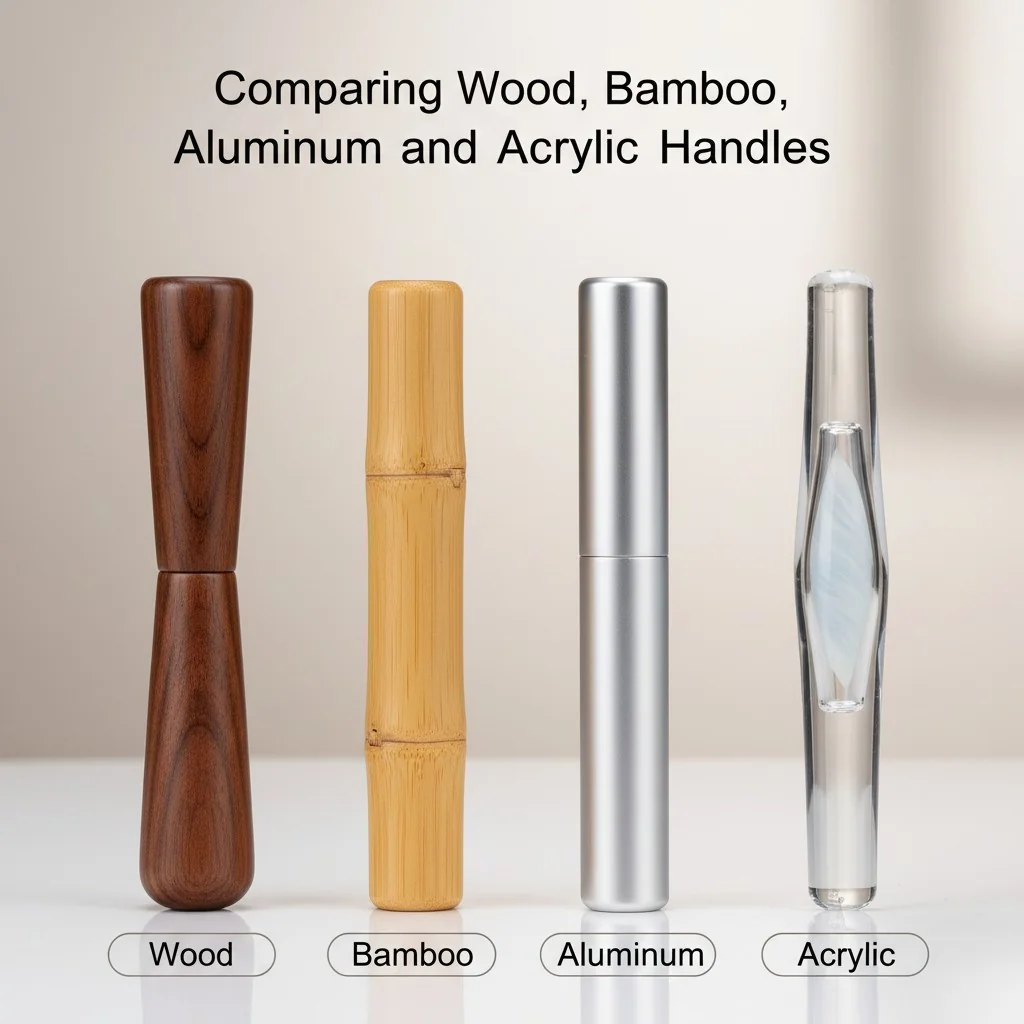
I always tell my clients to treat the "finish first." Think about how your customers will use and clean their brushes. Will they use strong brush cleaners? Will the brushes live in a steamy bathroom? The finish has to withstand that. A cheap soft-touch coating might feel nice at first, but it can get sticky or peel off. Anodized aluminum or a high-quality PU coat will last much longer. Let’s dive into the most common materials.
Material Deep-Dive
Here is a quick guide to help you map each material to your brand. I’ve seen these materials used for every type of brand, from mass-market to luxury. The key is the execution and the finish.
| Material | Brand Feel | Weight/Balance | Moisture/Heat Behavior | Finish Options | Sustainability Notes | Typical Risks |
|---|---|---|---|---|---|---|
| Wood/FSC | Luxury, Natural, Pro | Medium to Heavy | Needs quality sealing to prevent warping/cracking. | Lacquer, Paint, Stain, Laser Etch | Renewable; get FSC certificate for proof. | Warping, cracking if not sealed properly. |
| Bamboo | Eco, Natural, Light | Lightweight | Needs robust sealing; can swell in high humidity. | Natural Finish, Light Paint, Laser Etch | Fast-growing, renewable resource. | Splintering or swelling if poorly sealed. |
| Aluminum | Premium, Tech, Pro | Light but strong feel | Excellent resistance to moisture and corrosion. | Anodizing, Paint, Laser Etch, Polish | Highly recyclable; strong circularity story. | Dents on impact; cheap alloys can corrode. |
| Acrylic/Resin | Decorative, Fun, Gift | Can be heavy | Good moisture resistance; can be brittle. | High-Gloss, Internal Glitter/Fills, Print | Virgin plastic; look for PCR options. | Scratching, UV yellowing, cracking if dropped. |
| PCR/PLA | Eco-conscious, Modern | Lightweight | Varies; requires testing for heat/moisture stability. | Matte/Textured, Simple Print | Uses recycled or bio-based content; need docs. | Lower durability, potential for warping. |
Data sources: TaikiUSA, SY Beauty, The Aluminum Association, US EPA.
Anodized aluminum is my top pick for durability. It has a cool-to-the-touch, premium feel and the finish is incredibly resistant to scratches and solvents from makeup or cleaners. For brands with a strong eco-story, bamboo and FSC-certified wood are fantastic. They give a visible "natural" look that customers love. Just make sure your supplier uses a high-quality sealant. I always specify humidity soak tests during sampling to check for warping. For acrylic, which is perfect for fun, decorative handles, you must ask for UV stabilizers to prevent yellowing over time.
Anodized aluminum handles are the most durable option for professional makeup artists.True
Anodizing creates a hard, corrosion-resistant layer that holds up exceptionally well against frequent cleaning with solvents, making it ideal for pro kits.
FSC certification is just a marketing term with no real verification.False
FSC (Forest Stewardship Council) is a rigorous, third-party certification that ensures wood products come from responsibly managed forests. Retailers often require this documentation.
Which handle styles maximize ergonomics, retail impact, and refill/interchangeable use?
Your brushes look nice, but artists find them tiring to use. Or they get lost on a crowded retail shelf. Poor design means lost sales and a weak brand identity. Choose your handle shape strategically.
Ergonomic profiles3 with textured grips are best for pro use. Decorative, filled handles create retail pop for gift sets. Interchangeable systems reduce waste and appeal to eco-conscious consumers by offering modularity.
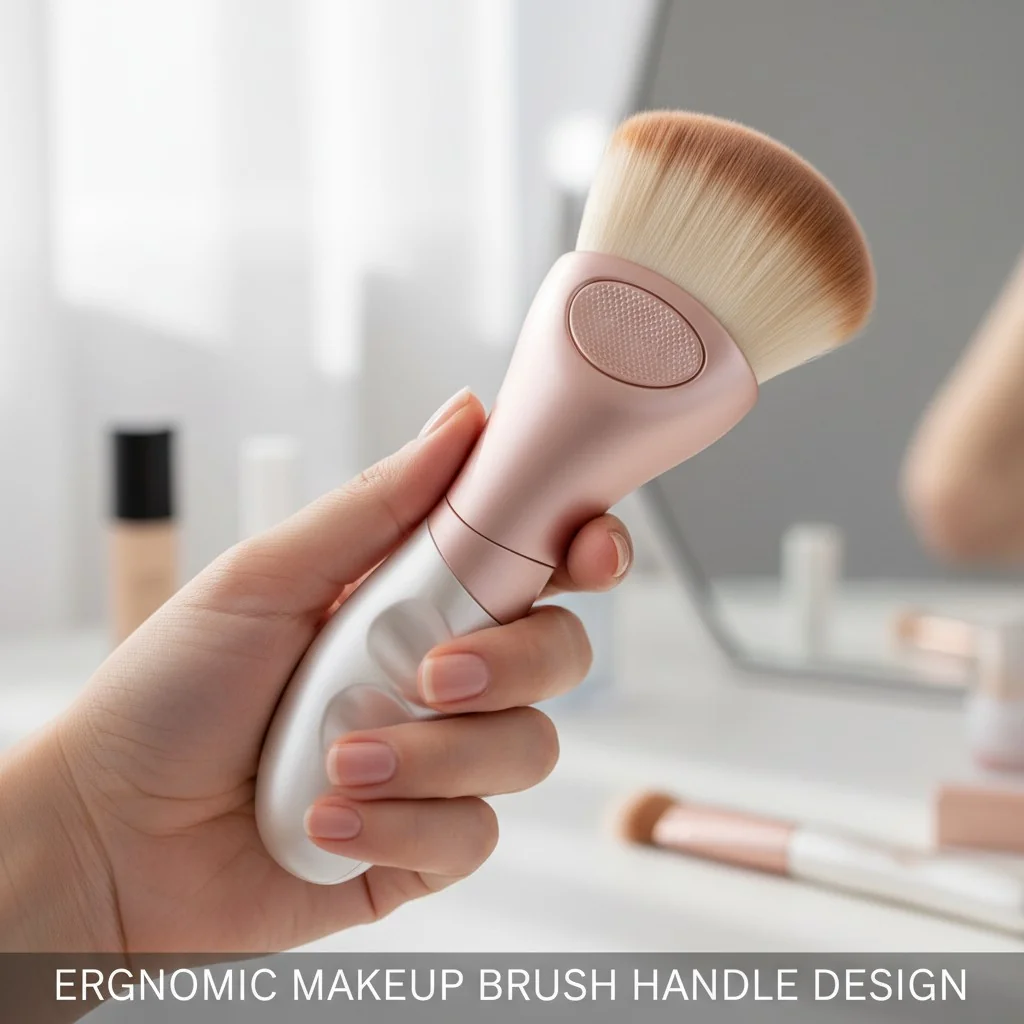
The shape and feel of a handle are just as important as the material. It’s about the user experience (UX) and how the brush presents itself in a store. For a professional artist who uses a brush for hours, balance and grip are everything. For a gift set, visual "wow" factor is key. I’ve worked with brands to develop unique shapes that become part of their signature. A triangular handle, for example, not only feels great but also stops the brush from rolling off a table. It’s these small details that elevate a product.
Styles for UX and Merchandising
- Ergonomic and Pro-Use: Think about handles with a thicker belly for balance or a tapered shape for precision. I often recommend adding subtle textures or a flattened side for better grip and control. This reduces hand fatigue for makeup artists. The weight of the material also plays a huge role in creating that perfect balance.
- Decorative and Retail Impact: This is where you can have fun. Acrylic handles can be filled with glitter, pearls, or even floating charms. We can create beautiful marbled or tortoiseshell effects with resin. These styles are perfect for holiday collections and gift sets because they have a high perceived value and look amazing on social media. Just be sure any internal fills are secure and meet safety standards.
- Travel and Interchangeable: Retractable or short-handled brushes are essential for travel kits. For Interchangeable systems4, a single handle can work with multiple brush heads. This is a great story for sustainability and waste reduction. When we develop these, I always insist on cycle testing the locking mechanism to make sure it stays tight after hundreds of swaps.
Interchangeable brush handles are a new trend that helps reduce packaging waste.True
Modular systems with one handle and multiple heads are gaining popularity as they reduce material consumption and offer consumers a customizable, space-saving solution.
A heavier brush is always better balanced.False
Balance is about weight distribution, not total weight. A well-balanced brush has its center of gravity where the handle meets the ferrule, making it feel like an extension of your hand, regardless of whether it's heavy or light.
What MOQs, lead times, and branding options should you expect for custom handles?
You have a great design, but you’re unsure about the production reality. Misunderstanding MOQs and Lead times5 can delay your launch and ruin your budget. You need to know the numbers before you commit.
Expect MOQs around 5,000 units for a single design, or 1,000 units each for five different designs. Standard lead times are 8–10 weeks after you approve the final artwork and place your order.
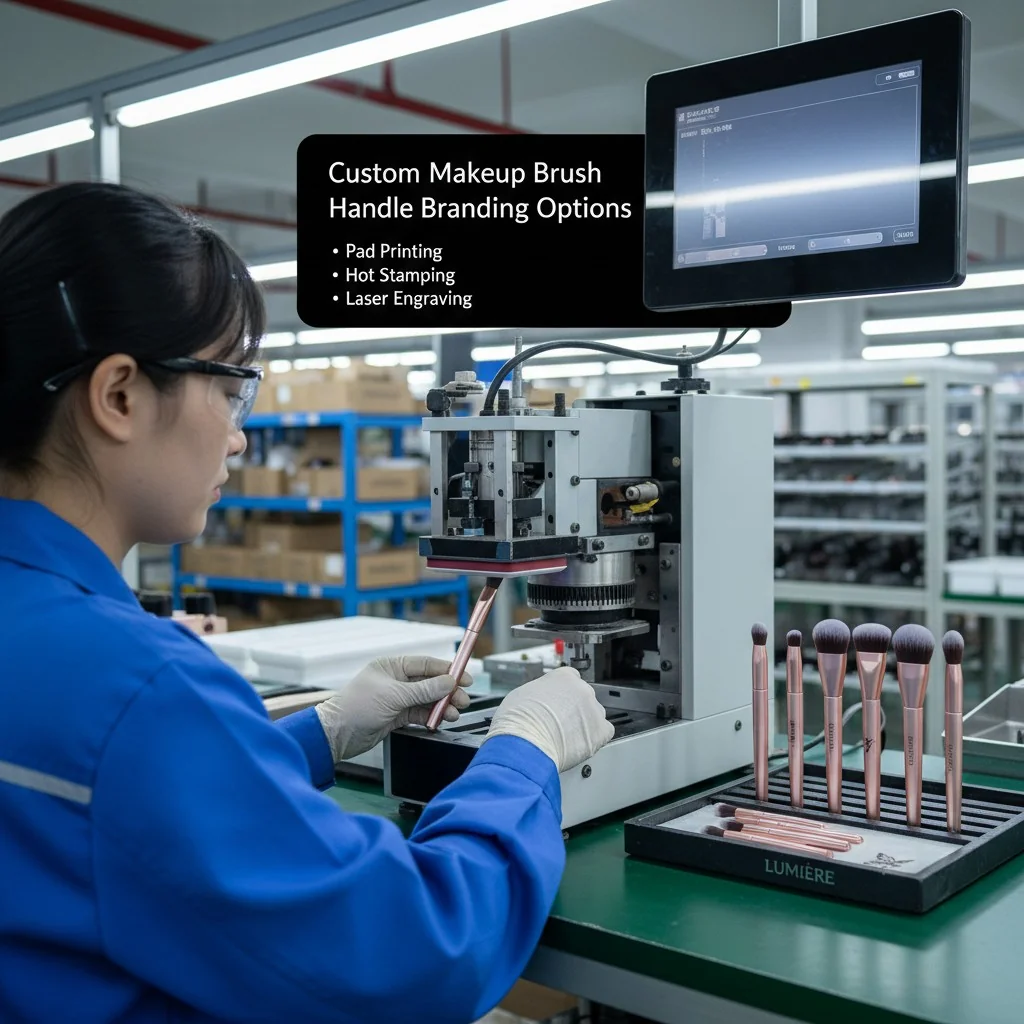
This is one of the first conversations I have with new clients. It’s so important to be realistic about production from day one. I’ve seen founders get their hearts set on a complex design, only to find out the MOQ is way beyond their budget. That’s why at Brushino, we try to be flexible. For indie brands, ordering 5,000 of one brush is a lot. So, we offer a tiered structure. You can get a lower MOQ of 1,000 units per style if you order a set of five brushes. This lets you launch a full collection without massive inventory risk.
Customization Workflow
- MOQs and Lead Times: The numbers I gave—5,000 units for one design or 1,000 units across five—are typical. The lead time of 8–10 weeks is also standard. This clock starts after you sign off on the pre-production sample and all artwork. Rushing this process is a recipe for mistakes, so plan your launch calendar accordingly.
- Branding Options: You have many ways to put your logo on a handle.
- Silk Screen/Pad Printing: This is the most common method for one or two-color logos. It’s cost-effective and versatile.
- Hot Stamping: This uses a heated die and foil to press your logo onto the handle. It gives a beautiful metallic or pigmented effect.
- Laser Etching: This is perfect for wood, bamboo, and anodized aluminum. It creates a clean, permanent mark that feels very premium.
- Color Matching: Yes, we can match everything! You can provide a Pantone code, and we can match the handle color, the ferrule, and even the synthetic fibers. This creates a cohesive, professional look that strengthens your brand identity. We always provide lab dips and samples for your approval.
The production lead time includes the time it takes to design the brush.False
The 8–10 week lead time typically begins *after* the design is finalized and the pre-production sample is approved. The design and sampling phase is a separate step that comes first.
You can Pantone match the handle, ferrule, and fibers of a makeup brush.True
Experienced OEM/ODM suppliers can color-match all components of a brush to a specified Pantone code, ensuring perfect brand consistency across your product line.
Which sustainable handles pass real-world use and audits, and how to substantiate claims?
You want to make Sustainable claims6, but you’re worried about greenwashing. Retailers and customers will call you out if you don’t have proof. You need to choose materials with verifiable data.
Recycled aluminum has a powerful circularity story, saving ~95% energy. FSC-certified wood and bamboo are strong renewable options. For PCR/PLA plastics, always get documentation verifying the recycled content percentage.
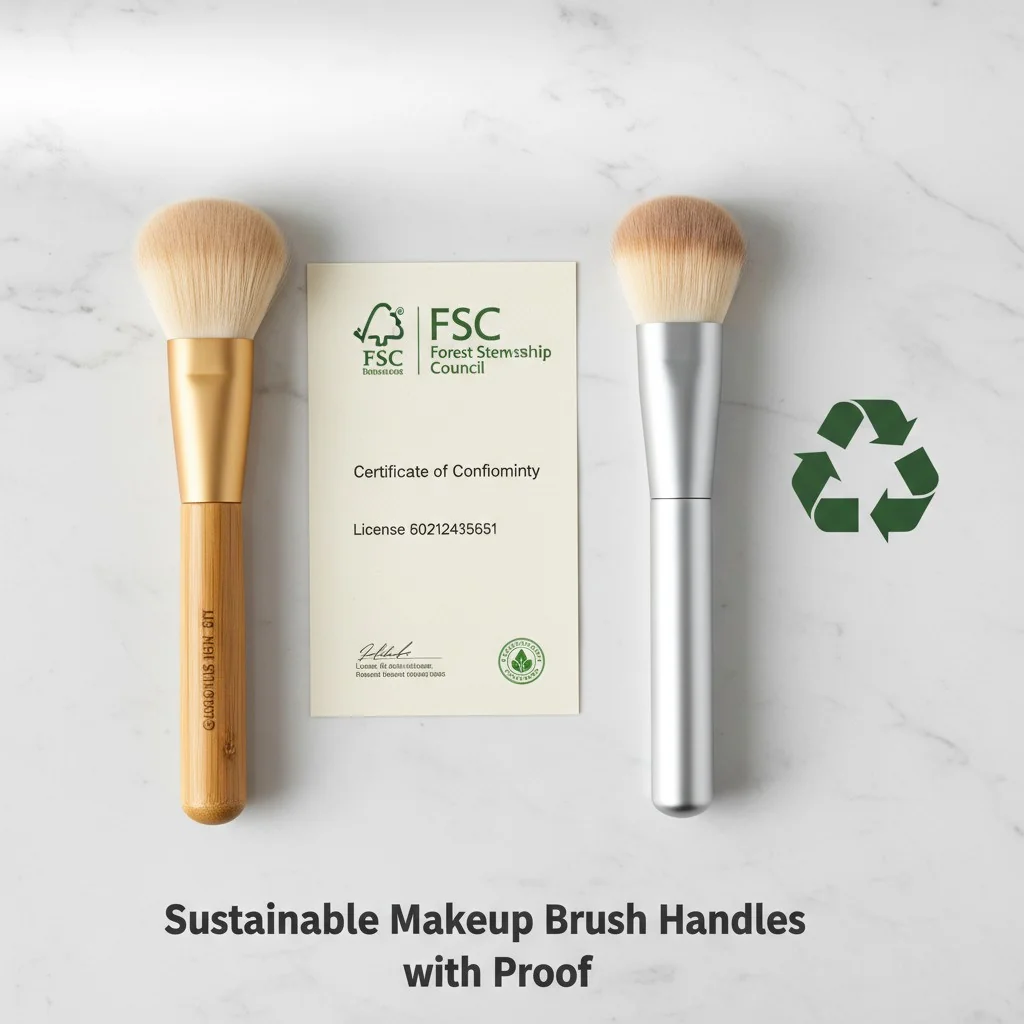
"Sustainability" is more than a slogan; it’s about proof. When I work with brands, especially those targeting major retailers, I stress the importance of documentation. Retailers will ask for it during line reviews. Customers are getting smarter and want to see the facts. A visible texture on a bamboo handle is great, but pairing it with an FSC certificate is even better. It builds trust and makes your claims credible.
Data-Backed Sustainability
- The Aluminum Circularity Story: This is my favorite sustainability story because the numbers are so powerful. Recycled aluminum uses only about 5% of the energy needed for new aluminum. And according to The Aluminum Association, about 75% of all aluminum ever produced is still in use today. This is a fantastic fact for your website’s sustainability page. It positions your product as part of a circular economy, not a disposable one.
- Bamboo and FSC-Wood: These materials tell a clear "renewable" story. Bamboo is a fast-growing grass, and FSC-certified wood comes from responsibly managed forests. The key here is getting the certificate from your supplier. Don’t just take their word for it. This documentation is what allows you to legally use the FSC logo on your packaging.
- PCR/PLA Plastics: Post-Consumer Recycled (PCR) plastic is a great way to reduce virgin plastic use. When you choose this, ask your supplier for a declaration stating the exact percentage of PCR content. PLA is a bio-plastic, often made from corn starch. It’s compostable, but you need to be clear about the specific composting conditions required. Honesty is the best policy here.
Using recycled aluminum saves about 95% of the energy compared to making new aluminum.True
This widely-reported statistic from the aluminum industry is a powerful and easy-to-verify fact to support your brand's commitment to sustainability and energy conservation.
All bio-plastics like PLA will break down in a home compost bin.False
Many PLA plastics require industrial composting facilities with high heat to break down properly. It's crucial to be transparent with consumers about the correct disposal method.
Conclusion
Choosing the right handle aligns your brand story, budget, and quality. Focus on the material, finish, and verifiable claims to build a product that lasts and customers love.
References
-
Anodized aluminum offers exceptional durability and a premium feel, making it a top choice for makeup brush handles. ↩
-
Understanding material durability is crucial for ensuring that makeup brushes withstand daily use and maintain their quality over time. ↩
-
Ergonomic profiles enhance user comfort and control, making them essential for professional makeup artists who use brushes for extended periods. ↩
-
Interchangeable systems reduce waste and offer customization, appealing to eco-conscious consumers and enhancing product versatility. ↩
-
Understanding lead times is essential for planning product launches and managing inventory effectively. ↩
-
Substantiating sustainable claims with verifiable data builds trust with consumers and retailers, enhancing brand credibility. ↩

